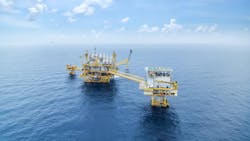PTTEP launches Thailand’s first offshore carbon capture and storage development
PTTEP has provided updates on several global offshore developments and new field projects.
Its CCS project at Arthit will utilize existing infrastructure and new facilities, with a total investment of about $320 million over five years.
PTTEP is also actively involved in offshore field development, including projects in Myanmar, Malaysia and Vietnam, with several FIDs and new platform constructions underway.
CCS project at Arthit gas field reaches FID
PTTEP has taken FID on Thailand’s first carbon capture and storage (CCS) project.
This will capture and store up to 1 MMmt/year of CO2 at the Arthit gas field in the Gulf of Thailand.
Operations should begin in 2028, without impacting gas production at the field. This is also intended as a pilot initiative to demonstrate/promote broader CCS implementation in Thailand, including in the northern part of the Gulf (Eastern Thailand CCS Hub).
PTTEP said it had performed extensive studies and assessments in preparation for the project, covering all aspects from storage site selection (reservoirs at depths of 1,000–2,000 m), to engineering design, measurement, monitoring and verification programs
The company plans to use existing infrastructure at the Arthit Field while also installing new facilities where needed. It estimates the cost of the five-year program at about $320 million.
To expand R&D and application of CCS technology in Thailand, PTTEP has collaborated with the Department of Mineral Fuels to provide funds for nine projects to seven academic and research institutions, covering multiple activities.
Relocations, FIDs and field developments
In a results update, the company revealed that it had recently relocated and installed the topsides of two wellhead platforms operating on the offshore G1/61 Project for reuse elsewhere. And the topside of one of Arthit’s wellhead platforms is also due to be relocated and installed shortly.
Currently, PTTEP is seeking approval from the Department of Mineral Fuels for the reuse of the G1/61 wellhead platform jacket, which it aims to relocate and install at a new location in 2026.
Elsewhere, the company is working on FIDs for the Abu Dhabi Offshore 2 Project—Waset area, and various Malaysian offshore greenfield developments, all said to offer long-term production potential,
Among its current overseas field developments, a new Phase 1E wellhead platform is under construction for the Zawtika gas field in Gulf of Moattama, offshore Myanmar. An investment decision is also under consideration for the Myanmar 3 project in the same basin, with first production expected in 2028 at a rate of 60 MMcf/d.
New projects in Malaysian waters include:
- Offshore Sabah Block K and Gumusut-Kakap (GK) fields. Block K produces oil and gas from the deepwater Kikeh, Siakap North-Petai (SNP). The partners have taken FID on Phase 3B, which will increase production by about 20,000 bbl/d by mid-2026.
- Offshore Sarawak SK410B: A re-engineering process is underway for the Lang Lebah Field to reduce development costs. A development of the Paprika Field is also under review, with FID expected next year followed by first production in 2028.
- Offshore Sarawak SK405B: Tenders are out for the EPCIC contract for the development of the Sirung and Chenda fields, with a planned startup in 2028.
- Offshore Sarawak SK438: FEED is nearing completion for the shallow-water Babadon Field development, also expected to start production in 2028.
- Ghasha Concession Project offshore the UAE: Gas production should begin in early 2026 from the Dalma Field northwest of Abu Dhabi at an initial rate of 340 MMcf/d.
- Offshore southeast Vietnam 16-1 and 9-2 projects: PTTEP has signed petroleum contracts to extend the concessions through 2031 and 2032, respectively.
SLB secures EPC contract for two deepwater fields offshore Malaysia
The contracts build on the 20-year collaboration between SLB and PTTEP.
About the Author
Jeremy Beckman
Editor, Europe
Jeremy Beckman has been Editor Europe, Offshore since 1992. Prior to joining Offshore he was a freelance journalist for eight years, working for a variety of electronics, computing and scientific journals in the UK. He regularly writes news columns on trends and events both in the NW Europe offshore region and globally. He also writes features on developments and technology in exploration and production.

